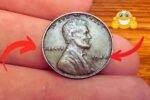1943 Lincoln Penny: A routine attic cleaning in Ohio has unearthed a remarkable piece of American history, sparking renewed interest in wartime coinage across the nation. What began as a family’s sentimental journey through childhood memories turned into an extraordinary numismatic discovery when a 1943 steel Lincoln penny was found hidden inside a well-loved teddy bear.
An Accidental Discovery with Historic Significance
The remarkable chain of events began when the Henderson family of Toledo, Ohio, decided to sort through generations of stored belongings. As they prepared to donate an old stuffed bear that had been passed down through the family, a small tear in the fabric revealed an unexpected metallic glint. Inside the stuffing, carefully concealed for decades, rested what appeared to be an ordinary penny.
Upon closer examination, the family noticed two unusual characteristics: the coin’s distinctive silver-gray color and the date “1943” stamped clearly on its surface. These details would lead them to discover they had found one of the famous steel pennies minted during World War II, when copper was diverted for military use.
Understanding the 1943 Steel Penny’s Rarity
The U.S. Mint produced over a billion steel pennies in 1943, but several factors make this particular discovery noteworthy:
- Exceptional Preservation: Protected inside the teddy bear for decades, the coin avoided the rust and corrosion that damaged most surviving steel pennies
- Historical Context: These coins represent America’s homefront sacrifice during WWII
- Potential Value: While common steel pennies might be worth a few dollars, pristine examples like this one could command hundreds
- Unique Provenance: The coin’s hiding place in a childhood toy adds to its story and appeal
Numismatic experts have been particularly intrigued by the discovery method. “Finding coins in this condition is rare enough,” explains coin historian Dr. Miriam Chen. “But to have one preserved this way, inside a personal artifact with clear sentimental value, makes it doubly special.”
The National Phenomenon Unfolds
News of the discovery spread rapidly through social media, triggering what collectors are calling “The Great Penny Search of 2025.” Across the country, Americans have begun:
- Sorting through old coin collections
- Examining childhood keepsakes for hidden treasures
- Visiting local coin shops with questions about vintage pennies
- Researching the history of wartime U.S. currency
Antique stores and thrift shops report increased interest in vintage toys and containers that might conceal old coins. Online searches for “1943 penny” have skyrocketed, and coin grading services report a surge in submissions.
Expert Advice for Aspiring Treasure Hunters
While the excitement is palpable, professional numismatists urge caution:
- Manage Expectations: Most 1943 steel pennies in circulation are worth modest amounts
- Look for Key Features: Genuine steel pennies will be magnetic and show no copper coloring
- Beware of Altered Coins: Some unscrupulous sellers plate copper pennies to mimic the rare steel versions
- Consult Professionals: Reputable coin dealers can provide proper evaluations
The American Numismatic Association has launched an educational campaign to help the public understand what makes certain coins valuable, hoping to channel the newfound interest into lasting appreciation for coin collecting.
More Than Metal: The Human Story Behind the Find
Beyond its potential monetary value, the teddy bear penny represents a tangible connection to America’s past. The coin’s journey from wartime circulation to childhood keepsake and finally to modern-day discovery mirrors the nation’s own evolution.
For the Henderson family, the penny has become a cherished heirloom that bridges generations. “We may have it professionally graded,” shared family spokesperson Jessica Henderson, “but we’ll never sell it. This isn’t just a coin—it’s part of our family story now.”
A Renewed Appreciation for Everyday History
This nationwide coin craze highlights how ordinary objects can become extraordinary with time. As Americans search through their attics and coin jars, many are rediscovering not just potential treasures, but forgotten stories and personal histories.
Whether the trend leads to valuable finds or simply sparks conversations about history, one thing is certain: people will never look at pocket change—or childhood toys—quite the same way again.



